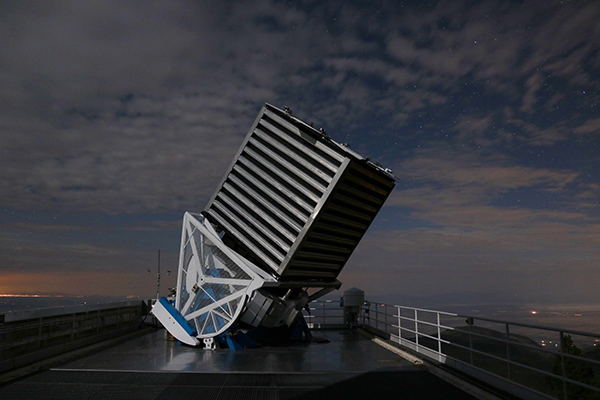This page shows images associated with the Sloan Digital Sky Survey. For more images, see our previous image galleries. To reuse these images, see Image Permissions.
SDSS and du Pont Telescopes

Image credit: SDSS

Image credit: SDSS/Patrick Gaulme

Image credit: SDSS/David Law

Image credit: SDSS/LCO
Focal Plane System
Video credit: SDSS/Rick Pogge
Download this video

Image credit: SDSS/Rick Pogge
Video credit: SDSS/Conor Sayres
Download this video
Local Volume Mapper
Video credit: SDSS
Download this video

The four Local Volume Mapper (LVM) telescopes inside the open LVM enclosure at Las Campanas in Chile. The black boxes to the right of the telescopes are the optical benches that channel the light from the telescopes down bundles of optical fibers to spectrographs in the room under the roof on the right. Of these four telescopes, only one observes the target area of sky with two others observing calibration fields and another observing targets of known brightness for calibration.
Image credit: SDSS/Nick Konidaris

Image credit: SDSS/Maximilian Haaberle

Image credit: SDSS/Yuri Beletzki

Each individual hexagon here represents one LVM observation
Image credit: SDSS/Héctor Ibarra

Image credit: SDSS/Aida Wofford
Milky Way Mapper
The video starts from our perspective on Earth showing some regions of the sky observed by MWM and then zooms out to show our Galaxy from a distance. From this latter perspective the observations appear centered on one spot, the Earth’s position in the Milky Way. The color of the stars then changes to show the metal content (also known as metallicity) of the stars. Stars marked as yellow points have metal content similar to our Sun. Stars marked as blue points have spectra that have low metallic content relative to the sun. Stars marked as red points are rich in metal content relative to our Sun.
Video Credit: Szabolcs Mészáros, Vanda Lendvai for the SDSS Milky Way Mapper
Image credits:
https://www.cosmos.esa.int/web/gaia/gaiadr2_gaiaskyincolour
https://www.esa.int/ESA_Multimedia/Images/2025/01/The_best_Milky_Way_map_by_Gaia
Song: Stars In Her Skies
Composer: Scott Buckley
Website: https://youtube.com/user/musicbyscottb
License: Creative Commons (BY 4.0) https://creativecommons.org/licenses/by/4.0/
Music powered by BreakingCopyright: https://breakingcopyright.com

Stars observed by Milky Way Mapper are marked as colored point. These stars had their spectra observed by Milky Way Mapper and from those spectra SDSS astronomers determined the chemical composition of each of these stars. The color of each star represents the metal content (also known as metallicity) of each star. Stars marked as yellow have a metal content similar to the Sun. Stars marked as blue points have spectra that have low metallic content relative to the sun. Stars marked as red points are rich in metal content relative to our Sun.
You can see here that the further away you go from the plane (the middle line) of the Galactic disk, the fewer metals a typical star has. This is because these stars are older. They formed from gas with a lower metal content. As time has gone on, successive generations have stars have enriched the gas that forms the fuel for star formation. This means younger stars (which lie closer to the plane) have a higher metal content.
Image Credit: Szabolcs Mészáros, Vanda Lendvai for the SDSS Milky Way Mapper
Galaxy image credits:
https://www.cosmos.esa.int/web/gaia/gaiadr2_gaiaskyincolour
https://www.esa.int/ESA_Multimedia/Images/2025/01/The_best_Milky_Way_map_by_Gaia
Other SDSS Image Galleries
Many more images can be found on the Image Galleries of previous generations of the Sloan Digital Sky Survey:
Image Permissions
We provide all images on a Creative Commons Attribution license (CC-BY). Any SDSS image on the SDSS Web site may be downloaded, linked to, or otherwise used for any purpose, provided that you maintain the image credits. Unless otherwise stated, images should be credited to the Sloan Digital Sky Survey.
We note that:
- Your use of the image does not imply our endorsement of any product or service
- If the image is to be used on a Web page, we also ask as a courtesy that you provide a link back to our site at www.sdss.org
- All SDSS data released in our public data releases is considered in the public domain
Any questions about image use should be directed to the Astrophysical Research Consortium’s business office via ARC’s business manager as follows:
Alim Patten
ARC Business Manager
c/o Department of Astronomy, Box 351580
University of Washington
Seattle, WA 98195
Phone: +1-206-616-0035
Email: alimyp@uw.edu
